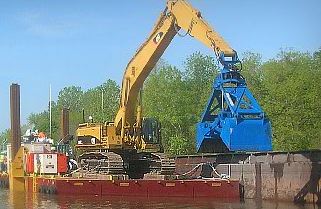 Calling it “An historic day for an historic river,” the EPA marked the start of dredging of the Upper Hudson River to remove PCB-contaminated sediment on Friday.
Calling it “An historic day for an historic river,” the EPA marked the start of dredging of the Upper Hudson River to remove PCB-contaminated sediment on Friday.
A river’s edge ceremony launched the beginning of the first phase of the six-year dredging project near Roger’s Island in Fort Edward, NY.
“The start of Hudson River dredging is a symbol of victory for the environment and for its river communities,” said George Pavlou, Acting EPA Regional Administrator. “Dredging will help restore the health of the river, and will one day allow people to eat fish that are caught between Fort Edward and Albany.”
“This is another chapter in the story of a river coming back from the brink,” Governor David A. Paterson said. “Forty years ago, the Hudson River was a poster child for pollution, mocked as an open sewer. But through the Clean Water Act, the upgrade of wastewater treatment plants and increased public vigilance fostered by the growing public interest in environmental protection, the Hudson has steadily improved and it is cleaner than it has been in decades. Today, we mark another step forward in the reclaiming of this river for the people and communities of New York.”
Under the terms of a November 2006 consent decree, General Electric Company will work 24 hours a day, six days a week to remove 265,000 cubic yards of sediment and 20,300 kilograms of PCBs from a six-mile stretch of the river between Roger’s Island and Thompson Island.
Sediment removed from the river will be carried by barge to a dewatering facility located on the Champlain Canal in Fort Edward. At this facility, water will be squeezed from the sediment and treated to drinking water standards before being returned to the canal. The remaining PCB-laden dirt will be loaded onto railcars for ultimate disposal at a permitted landfill facility in Andrews, Texas. The entire project will remove an estimated 1.8 million cubic yards of sediment and 113,000 kg of PCBs.
“We have come such a long way over the more than 25-year life of this project, and we could not have reached this day without the participation of literally thousands of people who care about the Hudson River and its legacy,” Pavlou added.
Information about the Hudson River PCBs Superfund site can be found at: www.epa.gov/hudson



















